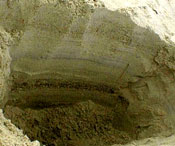| East Beach ~ Barrier Beach |
Physical Characteristics |
| East Beach ~ Barrier Beach |
Physical Characteristics |
Why are there layers of different colors and sizes of sand when you dig beneath the surface of the beach?The wave energy of the water near the shore is strong and keeps sand mixed in with the water. When the waves hit a beach, some of the sand falls out of the water onto the beach. The heavier, larger pieces of sand fall out of the water first, so they drop out lower on the beach nearer the water line. The lighter, smaller sand particles are carried higher onto the beach. This process is called natural sorting. The water level on the beach differs with the tide, so you can find heavier sand particles both high and low on the beach.
You can tell alot about the recent history of a beach by examining the sand on the beach or by digging a hole and looking at the layers of sand. In this photo you can see dark layers of color throughout the hole and a layer of larger sand particles near the top. The dark bands are less dense or lighter pieces of sand material. Those layers tell you that was where the water line was on the beach when the material was deposited. The dark bands were laid down on the beach at low tide and the large pieces of sand near the top of the hole were laid down at high tide. Often the layers will not be perfectly level but slope. This means that the hole was dug in part of the berm on the beach. The side of the berm towards the ocean often has a steep angle.

How does sand become sorted?Moving water has energy. It is able to pick up various sized sand particles (or sediments). The faster the water moves, the more energy it has which means it can carry larger or heavier sand pieces. Water with high energy can also carry more sediments. High energy water can carry sediments higher on the beach. This is why you often find debris from storm waves up near the dunes. Slow moving water has less energy and can't carry heavy particles so they settle out of the water. The more the water slows, the more material settles out. Some of the last sediments to settle or fall out of the water are the very small, very light clay particles.